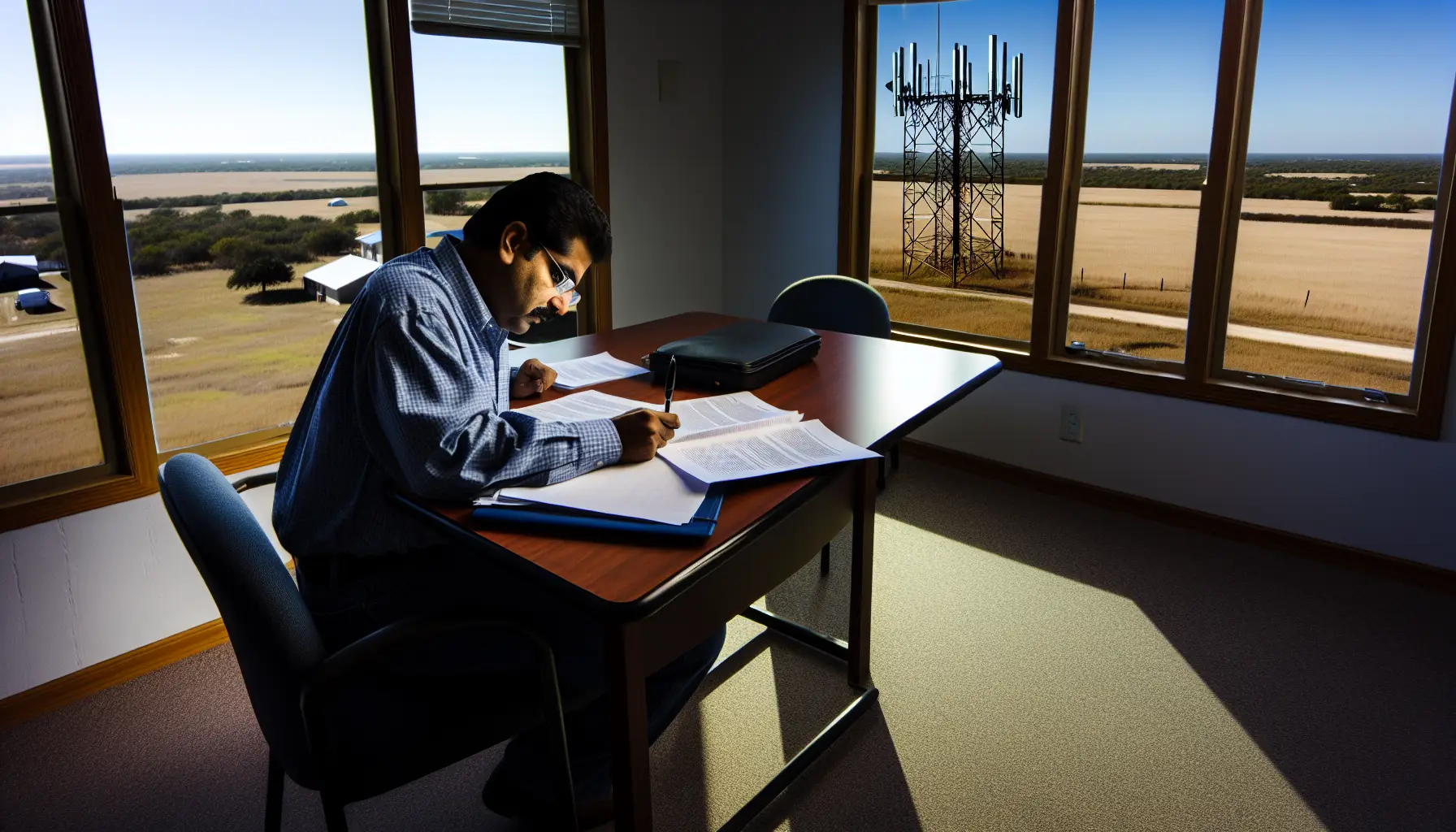Utility easements are important for rural land development. You might overlook them, but they can really affect your plans. These legal agreements permit utility companies to use a portion of your property for essential infrastructure like power lines, water lines, or communication lines. While these arrangements benefit communities by ensuring access to utilities, they pose unique challenges for landowners, especially during the planning and development stages of a project. Whether you are dealing with electric easements, water lines, or zoning restrictions, understanding the implications of utility easements can help you avoid costly mistakes and make informed decisions for your property.
In This Article:
What Are Utility Easements, and Why Are They Relevant?
A utility easement is a legal right that permits utility companies to install and maintain their infrastructure on your property. These easements are binding agreements that often come with specific terms, such as the type of utility, location, and access permissions. They can vary widely, from underground water pipelines to visible power lines that cross rural acres. For most rural landowners, these easements are non-negotiable, meaning they must balance land use with these pre-existing agreements.
When you own property, it’s important to be familiar with utilities and the concept of easements. But what exactly is a utility easement, and how does it influence your ownership?
The Basics of Utility Easements
A utility easement grants utility companies the right to use a portion of your land to maintain essential services, such as electricity, water, or gas. This means that a utility company has a legal claim to a specific section of your property if it is necessary for their services, potentially above or below ground. A utility easement is part of the property, regardless of changes in ownership or zoning. It can typically only be revoked by the company that holds the easement rights.
Identifying Easements on Your Property
To determine if your property includes a utility easement, check the property’s deed or consult with the real estate agency or title company that handled your transaction. Sometimes, easements might not be distinctly labeled, so they can be missed. You can also reach out to local authorities, utility providers, or even the previous owner for clarification. A thorough title search conducted by a title company will provide a definitive answer.
How Easements Affect Property Usage
Utility easements impose certain restrictions on the usage of your land. Since utility companies need constant access for maintenance and repairs, any obstruction on the easement area is prohibited. This means the land must be kept clear of any structures, such as sheds, pools, or even parked vehicles. For installations like driveways or fences, consult with the utility company or local government to ensure compliance with their requirements.
Why These Restrictions Matter
These restrictions exist to prioritize public safety and efficiency. Utility issues like water main breaks or gas leaks can pose significant risks, and unobstructed access is crucial for quick resolution. By respecting easement rules, you help maintain safety and ensure essential services remain operational and accessible.
Understanding and adhering to the conditions of a utility easement will safeguard not only your property interests but also community well-being.
Types of Utility Easements Common in Rural Areas
Not all utility easements are the same. Understanding the specific type that exists on your property is the first step in knowing how it may affect your land use or development plans. Common examples include:
- Electric Easements: These cover infrastructure such as power lines, transformers, and power substations. High-voltage lines often come with safety guidelines, requiring a buffer zone that could limit construction options.
- Water and Sewer Easements: These typically involve underground pipelines, drainage systems, or treatment facilities. Obstructions in these areas may require removal or relocation at the property owner’s expense.
- Communication Easements: Infrastructure such as telephone poles, fiber-optic cables, and even cell towers fall under this category. With the rise in rural broadband initiatives, these easements are becoming increasingly common.
Each of these easements requires careful consideration during rural development planning, as they directly impact how you can utilize your property.
How to Identify Utility Easements Through Title Reviews
A thorough title review is essential for anyone purchasing or developing rural land. Without fully understanding the existing easements on a property, you risk encountering legal and logistical challenges once development begins. Here are some practical steps to ensure you identify these easements during the title review process:
How to Find Utility Easements on Your Property
Locating utility easements on your property can be a straightforward process if you know where to look and who to ask. Here’s a comprehensive guide to help property owners uncover this vital information:
Check Existing Property Deeds:
- Utility easements are often documented within the property deeds. Start by reviewing any paperwork you received during the purchase of your home.
- Deeds and related documents can typically be obtained from the real estate agent or title company involved in your property transaction.
Contact Relevant Authorities:
- Reach out to your local government offices. City planning or zoning departments often hold records of easements for properties within their jurisdiction.
- Utility companies that service your area may also provide information about easements related to their infrastructure.
Talk to Previous Owners:
- If you’re still in touch with the previous property owner, consider asking them directly about any easements. They might have insights that aren’t readily apparent in official paperwork.
Conduct a Title Search:
- A title search can unveil hidden easements that might not be obvious. This in-depth search goes beyond the surface information and can highlight restrictions or shared usage rights tied to your property.
- Title companies can provide a detailed report that specifies any encumbrances, including easements.
Consult a Professional:
- If you’re having difficulty finding the information on your own, consider hiring a real estate attorney or a professional land surveyor. These experts can help verify the existence of easements and offer guidance on their implications.
By following these steps and utilizing available resources, property owners can confidently determine whether utility easements affect their land.
Steps to Discover Utility Easements
- Conduct a Title Search: Start by reviewing the property’s title to identify any recorded easements. These are often included in public records.
- Commission a Land Survey: A professional survey will visually map out any easements, giving you a clear picture of their exact location and size.
- Examine Recorded Documents: The terms of many utility easements are set out in public agreements that you can access through county records or the title company.
- Consult with the Title Insurance Company: They can help identify easements that may not be immediately obvious but could still impact your development plans.
Red Flags to Watch For
While some easements may only have a minor effect on your property use, others could drastically limit your plans. Pay special attention to easements that:
- Cover large portions of the property, reducing usable space.
- Have vague or overly broad terms, which could lead to legal disputes.
- Are shared by multiple utility providers, increasing traffic and potential maintenance disruptions.
Impacts on Land Development Plans
Utility easements directly influence how landowners can use and develop their property. Whether you are planning to build a home, install fencing, or develop a larger rural project, easements must be considered early in the planning phase to avoid costly redesigns or legal hurdles.
Development Constraints Caused by Easements
- You may not be able to construct buildings, fences, or other permanent structures within an easement zone.
- Planting trees or crops may also be restricted, as these could interfere with utility infrastructure.
- Access may be required for maintenance, meaning utility crews have the right to enter your property.
Additionally, zoning laws often specify setbacks from easements, further limiting construction or use in those areas. Ignoring these setbacks could lead to code violations or even legal penalties.
Negotiating Easement Terms to Your Advantage
Many property owners assume that utility easements are unchangeable. While their legal status makes them enforceable, there is often room for negotiation. Addressing these issues before purchasing land or beginning a project can make all the difference.
Refusal of Utility Easement
When you decide to refuse a utility easement, it’s important to consider the potential legal and financial implications involved. While you do have the right to deny access, this decision isn’t without its consequences.
Legal Considerations
- Legal Action by Utility Companies: Utility companies, such as Pacific Gas and Electric or Duke Energy, can take legal action if they feel their ability to serve the public is compromised. They may seek a court order, known as an injunction, to enforce the easement.
- Eminent Domain: In some cases, utility companies might leverage eminent domain laws. This legal concept allows them to acquire private land for public use, often offering market value as compensation. However, this can lead to lengthy legal battles and additional costs for legal defense.
Financial Implications
- Devaluation of Property: Refusing an easement could potentially lower the value of your property. Many buyers are wary of properties involved in legal disputes or those without necessary utilities access.
- Litigation Costs: If the situation escalates to legal proceedings, be prepared for substantial legal fees. Hiring attorneys and potentially losing the case could lead to significant financial burdens.
Practical Risks
- Service Disruption: Your decision may lead to service interruptions for you and possibly for your community, which could create friction with neighbors and local authorities.
Before making a decision, it’s critical to weigh these factors carefully and consider consulting with a lawyer who specializes in property law. This will ensure you understand all potential outcomes and make an informed choice based on your specific situation.
Practical Negotiation Strategies
- Adjust Boundaries: If the existing easement interferes with your project, propose modifications to its location.
- Set Clear Terms: Ensure that the scope of the easement is well-defined, minimizing potential disputes in the future.
- Control Access: Negotiate conditions that limit when and how utility companies can access the easement area to protect your privacy.
Compensation and Liability Considerations
In some cases, utility companies will offer compensation for the use of your land. However, it is equally important to clarify liability terms. For instance, who bears the cost if there is damage to your property during maintenance? Address these concerns upfront to safeguard your interests.
Legal Considerations and Final Best Practices
Utility easements are governed by specific real estate laws that vary by state. For Texas landowners, understanding the concept of dominant and servient estates is particularly critical. The utility company, as the dominant estate, has the right to use the land, but this right must stay within the scope outlined in the easement agreement.
The Role of Legal Counsel
An experienced Texas attorney can help you interpret easement terms, identify potential risks, and negotiate more favorable arrangements if needed. For example, a Houston real estate attorney can help protect your rights. They also balance the needs of utility companies and development goals. This is particularly valuable for complex transactions involving mineral rights, property disputes, or land use changes.
Conclusion
Rural land development comes with unique rewards, but also challenges like navigating utility easements. By conducting a thorough title review for Texas real estate and taking time to understand these agreements, you can align your plans with the legal and practical realities of land use. Proactively examining easements helps avoid disputes and ensures compliance with applicable laws and zoning requirements. For intricate matters involving utility easements or mineral rights, seeking professional guidance is invaluable. Partnering with Daughtrey Law Firm can help you protect your property interests and confidently move forward with your development plans.
FAQ’s Related to Utility Easement Texas
What are the possible consequences if a property owner refuses to grant a utility easement?
Refusing to grant a utility easement can lead to a series of complex legal and financial issues. Utility companies may respond by initiating legal action, such as seeking a court injunction or even invoking eminent domain, a process that allows them to use private land for public benefit with compensation. Financially, the refusal could reduce the property’s market appeal, especially if potential buyers are concerned about limited access to essential utilities. Additionally, legal proceedings might result in high attorney fees, court costs, and delays in resolving the matter. Refusing an easement without understanding the full scope of consequences can inadvertently lead to larger problems for the property owner.
What impact does a utility easement have on how I can use my property?
A utility easement can limit certain uses of your land, particularly where the easement is located. Property owners cannot build permanent structures—like garages, pools, or large fences—on the designated easement area, as utility companies require unobstructed access for maintenance and emergency repairs. Even landscaping or temporary structures may need to comply with specific guidelines to avoid interference. These limitations help ensure critical infrastructure remains operational and accessible, but they may restrict creative or functional development plans you have for that part of your property. Understanding these constraints early can help you make informed decisions about land use.
How can I find out if there’s a utility easement on a property I’m planning to purchase?
To identify existing utility easements on a property, start by reviewing the property’s deed and title documents, which typically list legal encumbrances. If the documentation is unclear or incomplete, contact your local zoning or planning department, as they often maintain public records of easements. You can also hire a title company to perform a comprehensive title search, which will reveal easements not easily visible in standard paperwork. Engaging a real estate attorney or land surveyor can also provide clarity and peace of mind before finalizing your purchase. Knowing whether an easement exists helps you assess any potential limitations and make an informed investment decision.
Is it legally permissible for a homeowner to deny a utility company access to their land?
While homeowners technically have the right to deny access to their land, doing so may trigger legal responses from the utility company. In situations where access is essential for delivering public services, utility providers may seek legal remedies, including court orders or invoking eminent domain laws. These legal avenues allow them to override refusal in exchange for fair market compensation. Refusal could also escalate into costly and time-consuming legal battles, potentially affecting your finances and relationships with neighbors relying on those services. Therefore, it’s essential to consult with a legal expert before taking action that could lead to such consequences.
Why do utility easement restrictions exist, and how do they benefit the community?
Restrictions on utility easements are implemented primarily to safeguard public infrastructure and ensure uninterrupted access for maintenance crews. These easement zones house critical utilities—like water mains, gas lines, or electrical cables—that, if obstructed, can pose safety hazards or service disruptions. In emergency situations, such as gas leaks or electrical outages, quick and unhindered access is crucial for preventing widespread damage or danger. These restrictions not only protect your own property but also ensure your neighbors and the broader community have reliable access to essential services. In this way, they function as a proactive measure to protect health, safety, and utility efficiency.











